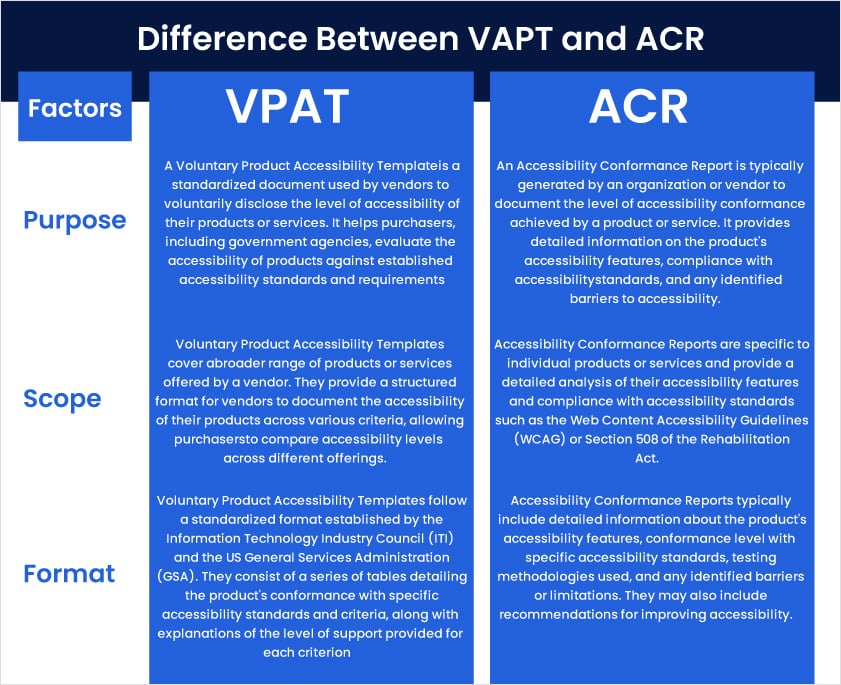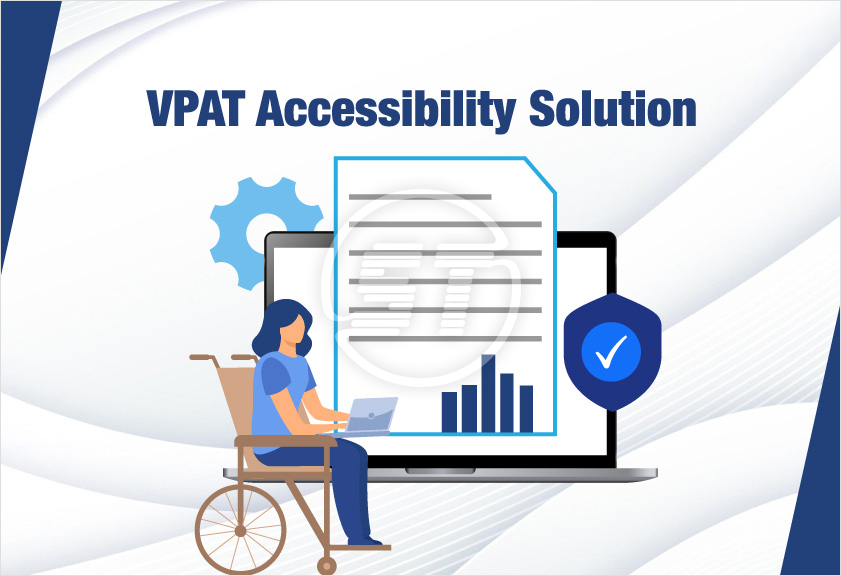Do you think digital accessibility is a buzzword only?
Well, it’s surely not.
Navigating accessibility solutions demands a strategic approach, and understanding the crucial questions to ask is paramount. In this article, we delve into the top common inquiries to consider before engaging with VPAT (Voluntary Product Accessibility Template) evaluations. From legal compliance to user experience enhancements, clarifying these aspects sets the foundation for fostering inclusivity and ensuring digital platforms cater to all users equitably.
Questions to ask web accessibility partners for a VPAT!
What is the process to complete a VPAT?
The process to fill and complete a
Voluntary Product Accessibility Template (VPAT)Understand Accessibility Standards:
Familiarize yourself with the relevant accessibility standards and guidelines applicable to your product or service. Common standards include the Web Content Accessibility Guidelines (WCAG) and Section 508 of the Rehabilitation Act.
Review Product Documentation:
Gather documentation related to your product or service, including user manuals, technical specifications, and design documents. Review these materials to understand the product's features, functionalities, and user interface elements.
Evaluate Accessibility Features:
Conduct a thorough evaluation of your product's accessibility features against the chosen accessibility standards. This assessment should cover various aspects such as keyboard navigation, screen reader compatibility, color contrast, and alternative text for images.
Use Testing Tools:
Utilize accessibility testing tools and assistive technologies to identify accessibility barriers and verify compliance with accessibility standards. Automated testing tools can help detect issues related to HTML markup, ARIA roles, and other technical aspects of accessibility.
Manual Testing:
Perform manual accessibility testing to supplement automated testing results. Manually test interactions, forms, multimedia elements, and other components to ensure they are accessible to users with disabilities.
Document Findings:
Document your findings in the VPAT template provided by the Information Technology Industry Council (ITI) and the US General Services Administration (GSA). The VPAT template consists of a series of tables organized by accessibility criteria, with options to indicate conformance levels (e.g., Supports, Partially Supports, Does Not Support).
Provide Explanations:
For each accessibility criterion, provide explanations and additional details to support your assessment. Include information about the level of support provided, any limitations or exceptions, and plans for addressing accessibility issues in future releases.
Seek Expert Input:
If needed, consult with accessibility experts or users with disabilities to gain insights into the usability and accessibility of your product. Their feedback can help identify potential barriers and improve the overall accessibility of your product.
Review and Revise:
Review the completed VPAT internally to ensure accuracy and completeness. Make any necessary revisions or updates based on feedback from stakeholders, testers, or accessibility experts.
Publish and Distribute:
Once finalized, publish the VPAT on your company website or provide it to prospective customers, especially government agencies or organizations with accessibility requirements. Be transparent about the accessibility of your product and make the VPAT readily available to interested parties.
The process begins with the audit of the product or service based on the applicable technical standards. The accessibility experts perform audit to address the key points outlined in the template, combining their expertise with the capabilities of an automated website accessibility audit. They leverage their in-depth knowledge and the insights from automated tools to conduct a thorough assessment and deliver a comprehensive final report. We have developed online free website accessibility scanner that scans the website for ADA, WCAG, UK Equality Act, California Unruh, European EN 301 549, Israeli Standard 5568, Australian DDA and Canada ACA.
After the assessment, they complete the VPAT by describing the product, evaluation methodologies, standard applied, conformance level, etc. The information ought to fill in various tables given in the template. Each section in the template is important to fill even if the product doesn’t conform to the standards or criteria.
What if a product has some non-conformant features as well?
As mentioned above, even if some of the parts of a digital product or service are non-conformant, reporting their status is harmless. The idea behind completing VPAT is to provide accurate and credible information about the product. Thus, furnish non-conformance information along with an explanation of exceptions or other reasons. These details help buyers understand the limitations and capabilities of the product and show the organization’s transparency and commitment to digital accessibility.
Who can fill a VPAT?
Accessibility experts: It is highly recommended that organizations collaborate with experienced accessibility experts or consultants because they can complete a VPAT appropriately, ensuring accessibility compliance.
Internal accessibility teams: Enterprises might have their inter accessibility teams with dedicated, seasoned professionals. These teams manage VPAT creation and other accessibility maintenance.
What supporting documents are required to complete a VPAT?
It is different for each organization, depending on the conformance level of the product, remediation strategies, and other methodologies. For instance, if any component of a digital product has received an exception from authorities, an exception certificate might be required.
What issues should be reviewed while updating the VPAT?
A high number of ‘Not Supported’ or ‘Partially Supported’ components of a product or service without clear explanation or further plans for improvement, require special attention. Since it shows there are significant accessibility issues and product needs thorough evaluation and remediation.
If a product is marked as ‘Supports’; however, it still reveals many accessibility issues, indicating that either the organization is not aware of the VPAT process or hiding the product’s accessibility level.
Another important point to verify is incomplete sections in VPAT. It is essential to mention the reasons why a section is incomplete.
If there are one or more generalized statements about conformance without specific information about success criteria, it suggests careful invigilation.
How to eliminate issues found in VPAT?
A minute observation/evaluation of all issues present across the product is highly suggested.
Based on the evaluation, make a comprehensive plan to address all the identified issues.
If a third-party expert/ web accessibility partner is involved in accessibility remediation, ensure to get results within an agreed timeline.
Set up a monitoring system to continuously track accessibility progress and ensure accessibility experts understand all requirements that are crucial for business growth.
Do accessibility challenges impact VPAT?
Certainly! There are evident accessibility challenges such as a lack of awareness of accessibility, compatibility with assistive technology, incomplete implementation of accessibility standards, etc. These problems influence VPAT completion significantly.
Is ACR different from VPAT?

Voluntary Product Accessibility Template (VPAT) offers a readymade template for organizations to generate a detailed Accessibility Conformance Report (ACR) of their digital products or services.
What are the benefits of VPAT?
It helps to ensure that a product or service is compliant with recommended accessibility standards.
While completing VPAT, organizations evaluate their products thoroughly and address the accessibility barriers that prevent some users from accessing the product, which ultimately improves user experience.
At times, VPAT is a legal requirement for organizations to sell their products. So, VPAT helps evade potential legal issues.
VPAT also displays organizations' commitment to accessibility and thus helps gain a competitive advantage.
And by improving user experience, showing commitment towards accessibility, and completing all legal requirements, organizations have better brand reputations.
What are the limitations of VPAT?
VPAT is a source of information, but it can be misleading as well. If a vendor displays a VPAT for its products, doesn’t mean the product is fully accessible. The quality of a VPAT is solely dependent on the expertise of the person completing it. Therefore, it is crucial to have a reliable web accessibility partner to complete the VPAT.
Also, each version of the product must have an updated VPAT. Outdated VPAT doesn’t convey right information about the updated product.
What standards does the VPAT follow?
Different industries and regions may have specific accessibility standards or guidelines. Ensure that the VPAT aligns with the relevant standards for the organization’s target audience. Common standards include Section 508 in the US and WCAG, which has become a global benchmark for web accessibility.
There are different editions of VPAT:
VPAT 2.5 508 edition – It is based on revised Section 508 standards.
VPAT 2.5 EU edition – based on EN 301 549 standards for the European Union’s ICT products and services.
VPAT 2.5 WCAG edition – This version is entirely based on W3C/WAO’s latest guidelines or ISO/IEC 40500.
VAPT 2.5 International (INT) edition – Includes all three of these standards.
What disabilities does the VPAT address?
Accessibility is not a one-size-fits-all concept. Different disabilities require distinct accommodations. Ensure that the VPAT considers a broad range of disabilities, including visual, auditory, motor, cognitive, and neurological impairments. A comprehensive evaluation will ensure inclusivity for all users.
Are there user testing and feedback incorporated into the VPAT?
User feedback is invaluable in identifying accessibility barriers and improving the user experience. The VPAT should include insights from individuals with disabilities through user testing, feedback sessions, or usability studies. Direct input from users can highlight issues that may not be apparent through automated testing alone.
The Skynet Technologies' approach to the VPAT report!
We are experienced in accessibility implementation, its assessment, and completing VPAT requirements. Our approach is straightforward for VPAT creation and its maintenance:
- Understanding the accessibility requirements and which standards are applicable to the product.
- Assessing each component/feature of the product against accessibility guidelines.
- Gather supporting documents for applied standards, methods, if exceptions are there, etc.
- Include remediation steps as well.
- Review the whole process of VPAT completion and then publish it.
- If approached for further/regular updates, we also provide continuous maintenance services.
In a nutshell,
Approaching accessibility solutions with a VPAT requires careful consideration and thorough evaluation. By asking the right questions to the web accessibility partners and ensuring a comprehensive assessment, organizations can address accessibility barriers, comply with legal requirements, and create inclusive digital experiences for all users. Accessibility is not just a checkbox; it is a commitment to equality, diversity, and inclusion in the digital landscape.
Are you ready to ensure your digital products are accessible to everyone? Our VPAT (Voluntary Product Accessibility Template) report services provide comprehensive evaluations of your website or digital assets accessibility compliance, empowering you to meet regulatory requirements and serve all users inclusively. Take the proactive step towards accessibility today. For more information, reach out us hello@skynettechnologies.com












